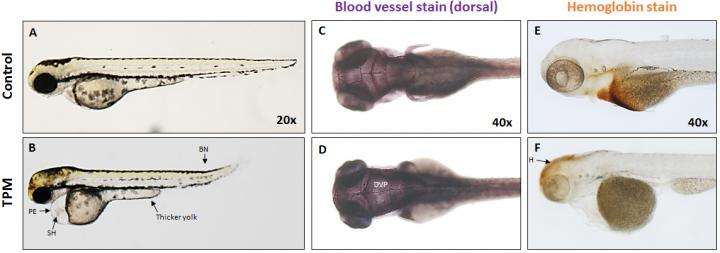Blocking key gene reduces cigarette smoke toxicity in fish embryos

A Duke University-led study shows how exposure to the particulate matter from cigarette smoke may affect early development in zebrafish embryos and increases the risk of neurological disorders and physical deformities.
The effects of this toxicity—which include malformed blood vessels and brain hemorrhages—can be reduced by blocking the production of a key receptor, the study finds.
Zebrafish are a widely used model species for studying human genetics and disease.
The researchers injected early-stage zebrafish embryos with a molecule to block a specific gene's activity and prevented the production of the aryl hydrocarbon receptor 2 (AHR2). This disrupted the metabolic pathway thought to play an important role in cigarette smoke toxicity.
"The knockdown resulted in a significant reduction in the incidence of deformities in the modified embryos," said Andrey Massarsky, a postdoctoral researcher in environmental toxicity at Duke's Nicholas School of the Environment. "Deformities still occurred, but far less frequently than in embryos without the modification," he said.
Massarsky and his team published their findings in the peer-reviewed journal Toxicology and Applied Pharmacology.
Numerous studies have linked exposure to the polycyclic aromatic hydrocarbons (PAHs) in cigarette smoke to increased risks of cancer, cardiovascular disease and poor fetal development in mice, zebrafish and other test species, but scientists are still working to identify and, potentially, learn how to prevent the precise pathway through which the toxicity occurs.
Initially, Massarsky and his colleagues hypothesized that their knockdown of the AHR2 receptor worked because it concurrently blocked the expression of the two main enzymes - cytochrome P450 1A (CYP1A) and cytochrome P450 1B1 (CYP1B1) - involved with PAH metabolism. But subsequent experiments, in which these enzymes were each knocked down, suggested there was more to it than that.
"We found that deformities were actually exacerbated when CYP1A and CYP1B1 were blocked," Massarsky said. "This shows that, if anything, these enzymes play a protective role. To some extent, they help prevent the deformities from occurring."
These seemingly contradictory findings could be because the CYP1A and CYP1B1 knockdowns may decrease the toxicity of some of the PAHs found in cigarette smoke's total particulate matter, while increasing the toxicity of others, he said.
But it is also possible that turning up the AHR2 pathway interferes with other biochemical signaling pathways. For example, recent studies show that activation of the AHR2 pathway may in fact inhibit the proper operation of pathways that pass signals into a cell through cell surface receptors. These pathways are critical to early embryonic development, particularly the formation of bone, heart and muscle tissues.
"These pathways are similar across vertebrates so it's likely that if these effects are happening in zebrafish, they could also happen in humans, mice and other species, though it's too early to say if the actual mechanisms are the same," Massarsky said. "Our new findings take us one step closer to an answer and direct us toward new avenues for future research."
More information: Andrey Massarsky et al, AHR2 morpholino knockdown reduces the toxicity of total particulate matter to zebrafish embryos, Toxicology and Applied Pharmacology (2016). DOI: 10.1016/j.taap.2016.08.024















